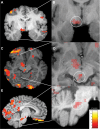Pathophysiology of Migraine: A Disorder of Sensory Processing
- PMID: 28179394
- PMCID: PMC5539409
- DOI: 10.1152/physrev.00034.2015
Pathophysiology of Migraine: A Disorder of Sensory Processing
Abstract
Plaguing humans for more than two millennia, manifest on every continent studied, and with more than one billion patients having an attack in any year, migraine stands as the sixth most common cause of disability on the planet. The pathophysiology of migraine has emerged from a historical consideration of the "humors" through mid-20th century distraction of the now defunct Vascular Theory to a clear place as a neurological disorder. It could be said there are three questions: why, how, and when? Why: migraine is largely accepted to be an inherited tendency for the brain to lose control of its inputs. How: the now classical trigeminal durovascular afferent pathway has been explored in laboratory and clinic; interrogated with immunohistochemistry to functional brain imaging to offer a roadmap of the attack. When: migraine attacks emerge due to a disorder of brain sensory processing that itself likely cycles, influenced by genetics and the environment. In the first, premonitory, phase that precedes headache, brain stem and diencephalic systems modulating afferent signals, light-photophobia or sound-phonophobia, begin to dysfunction and eventually to evolve to the pain phase and with time the resolution or postdromal phase. Understanding the biology of migraine through careful bench-based research has led to major classes of therapeutics being identified: triptans, serotonin 5-HT1B/1D receptor agonists; gepants, calcitonin gene-related peptide (CGRP) receptor antagonists; ditans, 5-HT1F receptor agonists, CGRP mechanisms monoclonal antibodies; and glurants, mGlu5 modulators; with the promise of more to come. Investment in understanding migraine has been very successful and leaves us at a new dawn, able to transform its impact on a global scale, as well as understand fundamental aspects of human biology.
Copyright © 2017 the American Physiological Society.
Figures









References
-
- Abe J, Hosokawa H, Okazawa M, Kandachi M, Sawada Y, Yamanaka K, Matsumura K, Kobayashi S. TRPM8 protein localization in trigeminal ganglion and taste papillae. Brain Res 136: 91–98, 2005. - PubMed
-
- Abizaid A. Ghrelin and dopamine: new insights on the peripheral regulation of appetite. J Neuroendocrinol 21: 787–793, 2009. - PubMed
-
- Adam JA, Menheere PP, van Dielen FM, Soeters PB, Buurman WA, Greve JW. Decreased plasma orexin-A levels in obese individuals. Int J Obes Relat Metab Disord 26: 274–276, 2002. - PubMed
Publication types
MeSH terms
Substances
Grants and funding
LinkOut - more resources
Full Text Sources
Other Literature Sources
Medical
Research Materials

